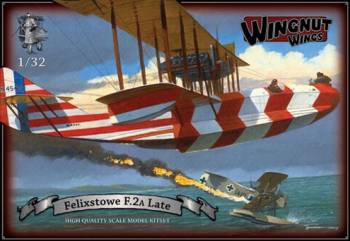The Felixstowe F.2a was probably the most successful flying boat of the First World War. With a crew of 5 it was capable of carrying out long range reconnaissance, anti-submarine and anti-shipping patrols of up to 10 hours duration. The development of the Felixstowe F.2a is staggeringly convoluted but it was essentially an Anglo-American design which can trace its roots to the pre war Glenn Curtiss & Cyril Porte designed 180hp twin engine ‘America’ flying boat design. This basic design was improved, enlarged, strengthened and repowered successively by both Curtiss and Porte (having now returned to service in the RNAS after the outbreak of war despite suffering from Tuberculosis) over the next few years until July 1917 when Porte arrived at the characteristic deep ‘V’ hull with full side fins. Although technically now a wholly Porte design these Felixstowe flying boats, so named because they were developed at the RNAS Seaplane Experimental Station at Felixstowe in Suffolk, were referred to as ‘Large Americas’ by the British and as ‘Curtiss’ types by the Germans.
The twin 375hp Rolls Royce Eagle VIII powered Felixstowe F.2a featured a deep ‘V’ hull constructed using boat building techniques with diagonal planking on the bottom while the tops of the fins were plywood and doped fabric. The sides of the forward superstructure were also plywood and t he top coamings were covered with linen, as were the wings and tailplane. Ply walkways were positioned on the top coaming near the engineer’s hatch and on the bottom wings below the engines. Early production F.2a were delivered with a glazed cabin, fabric covered sides of the rear hull and large unbalanced ailerons. Later developments included replacing the cabin with an open cockpit, balanced ailerons and strengthening the rear hull sides with ply or diagonally applied "Consuta" planks. Late production boats as depicted in this kitset had an open cockpit with strengthened rear hull with wooden sides and many had balanced ailerons fitted. Some early boats delivered with glazed cabins were later converted to open top configuration. A modified V12 Liberty engine powered version was manufactured by Curtiss in America as the H.16. The Felixstowe F.3, superficially similar in appearance to the F.2a but slightly larger and capable of carrying twice the bomb load, was put into production despite being considered inferior to the F.2a. The larger still Felixstowe F.5 similarly featured poorer performance but arrived too late to see operational service before the Armistice and a modified V12 Liberty engine powered version was manufactured by Curtiss in America as the F.5L. Any history of these aircraft here is of necessity very brief, therefore we encourage you to seek out the references listed below for a more thorough understanding of these significant aircraft.
Felixstowe flying boat wings and tailplane upper surfaces usually appear very dark in photographs and have been recorded simply as ‘green’ with the bottom surfaces remaining heavily varnished Clear Doped Linen (CDL). The bottom of the hull, bow, tops of the fins, and rear hull washboards were finished with gloss black bituminous tar based paint inside and out for waterproofing, as were the fabric wrapped side struts and tailplane struts. The plywood panels of the superstructure were heavily varnished with their joints often being sealed with the same bituminous tar based paint while the top coamings frequently remained CDL. In some instances the coamings were finished with the same dark protective dope as the wings and tailplane. All metal fittings were painted gloss black although those on the engine bearers and interplane struts appear to have frequently been overpainted with Battleship Grey (BSG) along with the wood. Most surfaces featured a gloss finish when new which quickly weathered to a dull matt appearance after short periods exposed to the harsh saltwater environment. Many British flying boats featured brightly coloured dazzle paint finishes for identification purposes from the middle of 1918 onwards.





















